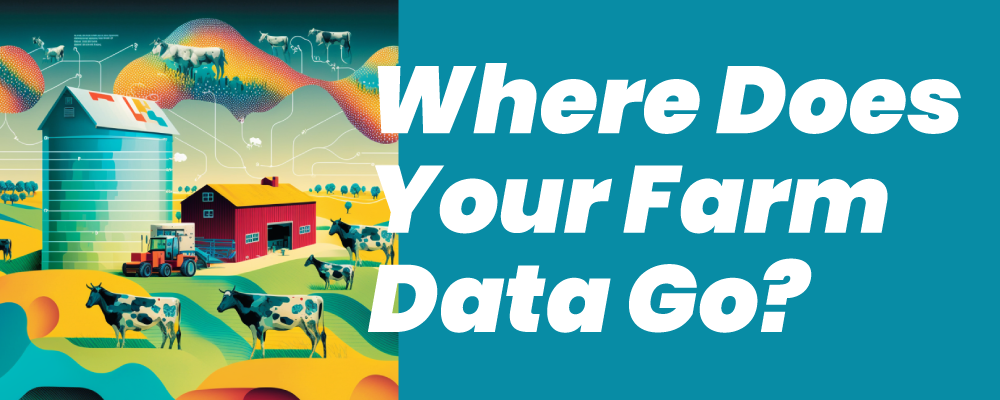Still, in its infancy, food animal AgriTech has barely scratched the surface of its appropriate applications, deployment, potential business models, and value in food animal agriculture, especially at the farm level, which the supply chain is working down to and trying to tap into that value. Much like our personal data, how sensitive and aware we have become of it, and where it goes, you also need to be concerned about your farm-level data (business data). When we look at the first generation of tools and models we have adopted on farms, we must also understand and trace their provenance, and where does your farm data go?
Data has a value. We know it’s large and significant that is both tangible and precision livestock farming decision support based, but what is the value of that data to US producers? Looking at so many other sectors that have taken control of their data, food animal producers need to begin to take control of their data as an important business asset. Producers and their farms are an essential part of the future generation of AgriTech and the continued supply of food animal products that are nutritious, produced humanely and sustainably, which data is now part of, enabling product plus data.
It is not far enough for AgriTech service providers to say they “believe in farm data ownership”; it must now be embedded in models and AgriTech tools being developed and deployed at the farm level. With the dominance of non-US-based AgriTech suppliers in the US food animal AgriTech market, which has a demand and dependency in supplying AgriTech technologies and accessing US farmer data, the US is the largest single livestock market, with large herds of valuable data.
With all the different AgriTech tools that are being considered for adoption or already on farms, do you know if your data stays in the US? Where are the cloud servers that operate your digital systems located? Who has access to it? Is it being used for developing new tools in other countries that could then be sold back to US farmers as an upgrade or new product?
If enough data is amassed, bad actors can work out sensitive details that identify the position, people, profit, preferences, and practices associated with the source. We have already seen this emerge in other sectors (Rocher et al, 2019), with huge consequences and liability. Even if the data centers are in the US vs. data centers in other countries or continents, those companies outside the US will still benefit from the centralization of your data, even if anonymized, while potentially governing your data flow, bottlenecking access, use, and enhanced value.
The value of food animal agriculture data must be independent of the disparate, data-centralizing, foreign AgriTech companies that offer models, products, and services to US farms. Food security is also now data security. It’s not to say there isn’t currently anything nefarious happening, but bad actors will always try to make a quick buck or identify areas of opportunity or vulnerability where marketing and selling anonymized data can be that quick buck or opportunity at the expense of rural producers and communities.
Today we have a few sources of rules and regulations governing AgriTech that is coming to market. To get ahead, US producers must lead in the ownership, security, and governance around their data, allowing an agricultural data economy to emerge that benefits rural communities, jobs, and economics in the US and on your farm. The MIT technology review article from December 2022 on The Worst Technology of 2022 reminds us that “One theme that emerges from our disaster list is how badly policy—the rules, processes, institutions, and ideals that govern technology’s use—can let us down. “ This is something we should learn from and build fortuity with as we progress from the first generation of AgriTech tools to the next.
Producers must begin to ask, where does their farm data go? This may go as far as to be considered within the future Trans-Atlantic Data Privacy Framework negotiations, deliberating on US producer data ownership and the geo-political relationship of food animal agriculture data, farm-level data, and EU AgriTech needs in the US market and US food national security.
As we progress further with farm-level digital adoption, producers, the data owner, and their AgriTech suppliers will either need to have a more symbiotic relationship or enable data ownership by the producer and their farm; that starts with data consolidation through a farm data ecosystem, bringing those disparate data into one location and understanding where your farm data goes, which is part of food animal Agri-penureship.
References
- Rocher, L. Hendrickx, J, M. de Montjoye, Y, A. 2019, Nature communications – Estimating the success of re-identifications in incomplete datasets using generative models | Nature Communications
- Your Data Were ‘Anonymized’? These Scientists Can Still Identify You – The New York Times (nytimes.com)
- Why Europe’s largest agtech fund wants to focus on US market | ZDNET
- Can Europe Dominate In Innovation Despite US Big Tech Lead? (forbes.com)
- The biggest technology failures of 2022 | MIT Technology Review
- An MIT Technology Review Series: AI Colonialism | MIT Technology Review
- The new transatlantic data privacy framework: What is it, and will it last? – Atlantic Council

